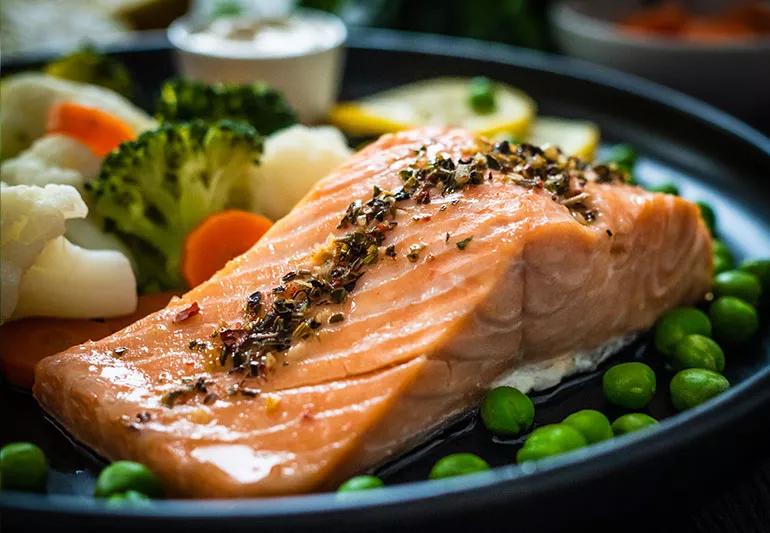Establish good eating habits with this diet full of locally sourced fruits, vegetables and seafood

It seems like there’s a new diet invented every day. There are many options that have caught our attention, like the flexitarian diet, “The 100” diet or the fruitarian diet — just to name a few.
Advertisement
Cleveland Clinic is a non-profit academic medical center. Advertising on our site helps support our mission. We do not endorse non-Cleveland Clinic products or services. Policy
But if you’ve heard of the Nordic diet (also known as the Scandinavian diet), you might be curious what it’s all about and if it’s just another fad diet.
The Nordic diet, which is based on principles that have been around for centuries, promotes a healthy way of eating by focusing on locally sourced fruits, vegetables and wild seafood.
Registered dietitian Courtney Barth, RD, explains what the Nordic diet is, what foods are included and if it might be right for you.
Very similar to the Mediterranean diet, the Nordic diet focuses on whole foods that are typically found in Nordic regions like Norway, Denmark and Iceland. You’ll eat mostly plant-based, seasonal foods that are high in protein, complex carbohydrates and healthy fats. Think fruits (especially berries), vegetables and seafood.
One difference, though, is the type of oil each diet uses. The Mediterranean diet focuses on using extra-virgin olive oil, while the Nordic diet touts canola oil. Canola oil has less saturated fat than extra-virgin olive oil and can be used in cooking and baking at a higher temperature than olive oil. It should be noted that most canola oil available in the U.S. is processed and lacks antioxidants compared to olive oil.
Advertisement
“Generally, both are good unsaturated, healthy anti-inflammatory oils,” says Barth.
The Nordic diet encourages people to consume less sugar and twice the amount of fiber and seafood than traditional Western diets.
By focusing on eating whole foods like fruits and vegetables, the Nordic diet can affect your health in a positive way. Here are some potential benefits:
“For people who have arthritis or joint pain incorporating more whole foods can be the way to reduce inflammation further,” says Barth.
The Nordic diet encourages you to eat a lot of whole foods, particularly sourced locally and in season, including:
You should also eat the following in moderation:
“Game meat is a good source of lean protein and is lower in saturated fat compared to red meats, which should be consumed once or twice a week,” says Barth.
Like many diets, the Nordic diet has a handful of foods to avoid or only enjoy rarely.
Rarely:
Avoid:
“Anything that’s really high in saturated fat and high in sugar is inflammatory to the body,” says Barth. “It causes the body to be stressed out.”
With a focus on eating locally sourced foods, following the Nordic diet can be a good way to try out local farmers markets in your area.
“Many of them will have a variety of booths with farmers who harvest fruits and vegetables that are in season,” says Barth. “You can also ask your local grocery store if they carry local produce and products.”
For some, following the Nordic diet could be challenging due to availability of local produce. It does take planning, so the time and commitment could be a challenge for some. Since produce like lingonberries and cloudberries aren’t available in the U.S., you may need to modify what you eat based on what’s available in your area.
But whether you focus on the local aspect of sourcing foods, the Nordic diet is a good roadmap for getting yourself into a realistic eating pattern. It can even be modified for vegans and vegetarians by adding more plant-based foods into your diet.
Advertisement
“The approach to the Nordic diet is more of a guideline that can be really sustainable for someone,” says Barth. “It’s just the basics and not overthinking or complicating what you eat.”
Advertisement
Learn more about our editorial process.
Advertisement

Choose foods that are low in fiber and easy to chew and swallow

The flexible eating plan aims to boost your brain health by focusing on plant-based foods and limiting saturated fat

Designed to lower your blood pressure, this eating plan focuses on heart-healthy foods like whole grains, fruits and vegetables

Pescatarians don’t eat poultry, game or red meat, but they do eat fish and seafood, dairy and eggs

This eating style has many health benefits, including weight loss, an improved microbiome, and increased nutrient and mineral consumption

Research shows promising results from options like the DASH diet and Mediterranean diet

Studies show intermittent fasting may help you lose weight, improve blood pressure and more

Some people can safely lose weight on just 1,200 calories — but it’s not right for everyone

Start having sex about 72 hours before ovulation, then at least every other day during your fertile window

Attachment theory suggests that your earliest relationships shape connections throughout your life

It isn’t a recognized mental health disorder, but research shows that problematic social media use can negatively affect your mental health, self-esteem and sleep